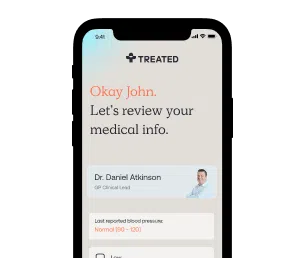Diabetes
Effective treatments to stabilise your blood sugar.
Secure delivery
UK clinicians
Diabetes is where your body struggles to control its levels of insulin. There are two types, and they can both provide barriers to everyday life.
Talk to us about your healthcare needs and we can advise you of which treatments can be right for you. Subscribe to Treated and receive your diabetes treatment as and when you need it.
Diabetes, also known as diabetes mellitus, is a chronic health problem that affects the body’s ability to produce insulin or use the blood sugar (or blood glucose) effectively.
Blood sugar levels are regulated by a hormone called insulin which is produced by the beta cells of the pancreas. Insulin is a hormone that helps glucose get into the cells where it's needed.
The pancreas plays a vital role in diabetes. If a person becomes diabetic, it means that the pancreas isn’t able to produce enough insulin required for the body or cells aren’t able to make proper use of the insulin produced.
Diabetes is broadly divided into: Type 1, Type 2 and Gestational Diabetes.
Type 1 diabetes is a health condition in which your immune system destroys the insulin-producing beta cells of the pancreas. So, they cannot produce any insulin. It usually occurs in children, teenagers and young people but can also occur at any age.
Type 2 diabetes is a condition in which cells become insensitive to insulin and cannot make use of the blood sugar effectively. As a result, blood glucose levels go up. It's milder and more common than type 1, but can lead to serious complications in your eyes, nerves, kidney and heart. In type 2 diabetes, there are two connected problems: your cells respond poorly to insulin, so can’t make use of the blood sugar effectively. And sometimes your pancreas doesn’t produce enough insulin.
Gestational diabetes is a health condition which occurs in pregnant women. During pregnancy, sometimes the body becomes insulin resistant and so blood sugar levels rise. This type of diabetes usually goes away after birth.
Gestational diabetes is of two classes. Women with A1 class are able to control it with the help of proper diet and regular exercise. While those with A2 class have to take medicines or insulin shots.
There’s also a form of diabetes known as ‘Latent Autoimmune Diabetes of Adulthood’ (or LADA) which is sometimes informally called ‘diabetes 1.5’. This is currently classified as a form of type 1 diabetes, but shares similarities with type 2 - hence the ‘1.5’. Research is currently being undertaken to find out what seems to make it different from both type 1 and 2 diabetes.
Type 1 diabetes can affect anyone at any time, but type 2 diabetes is usually acquired later in life. You are more likely to get type 2 diabetes if you’re over 40 (or over 25 if you’re south Asian), have a family history of diabetes, or are overweight or obese. Type 1 diabetes is thought to be caused by an autoimmune reaction that destroys the cells in the pancreas that make insulin, called beta cells. This process can go on for months or years before any symptoms appear. Some people have certain genes that make them more likely to develop type 1 diabetes.
Gestational diabetes happens when your blood sugar gets too high during pregnancy, and your body can’t make enough insulin to regulate it. Like type 2 diabetes, you’re at a higher risk of getting gestational diabetes if you’re overweight or have a family history of diabetes.
A 2016 study suggested that 9% of men and 7.9% of women worldwide could be diagnosed as having diabetes: a number that has risen by 28.5% since 1980. So it’s common, and it’s on the rise. This is generally thought to be because the world’s population is getting older and heavier.
Type 2 diabetes is more common than type 1, with an estimated 90% of diabetes sufferers having type 2, but both are for life. But where type 1 is unavoidable, it’s possible to minimise the risk of getting type 2 diabetes by living a healthy lifestyle. This type is the main reason for diabetes becoming more common.
In the case of gestational diabetes, it’s estimated that 2%-10% of yearly pregnancies are affected by it.

How we source info.
When we present you with stats, data, opinion or a consensus, we’ll tell you where this came from. And we’ll only present data as clinically reliable if it’s come from a reputable source, such as a state or government-funded health body, a peer-reviewed medical journal, or a recognised analytics or data body. Read more in our editorial policy.
The cause of type 1 diabetes is often genetic. If any of your parents or siblings have type 1 diabetes, you might get it as well.
Besides this, environmental factors, like viruses or other autoimmune disorders like Vitiligo or Graves’ disease may also cause it.
You might get type 2 diabetes due to genetics, lifestyle disorders or certain health conditions. If you are obese or overweight and lead a lifestyle with a lot of stress and no physical activity or exercise, you might develop type 2 diabetes mellitus. High blood pressure, low levels of “good cholesterol” high-density lipoprotein (HDL), high levels of triglycerides in the blood, or a family history of diabetes might also increase your chances of getting diabetes.
Gestational diabetes is another factor. If you had gestational diabetes during your pregnancy, you are at a higher risk of having type 2 diabetes.
The symptoms of type 1 and type 2 diabetes include extreme thirst, excessive hunger, sudden weight loss, frequent urination, tiredness, frequent infections of skin, gums, vaginal or urinary tract, slow-healing sores and blurry vision.
Many people, however, can have type 2 diabetes without realising. This is because the symptoms can be mild, and don’t necessarily make you feel unwell.
If left untreated and uncontrolled, diabetes can lead to a range of problems. These problems can be caused gradually, so it’s important to get an early diagnosis where possible, and keep good control over your blood sugar levels.
Complications of untreated diabetes can include: cardiovascular disease, nerve, kidney and eye damage, skin conditions, Alzheimers and depression.

How we source info.
When we present you with stats, data, opinion or a consensus, we’ll tell you where this came from. And we’ll only present data as clinically reliable if it’s come from a reputable source, such as a state or government-funded health body, a peer-reviewed medical journal, or a recognised analytics or data body. Read more in our editorial policy.
There are a range of different types of diabetes treatments which work to regulate your blood sugar levels.
Sometimes you might need to take a combination of some of these treatments, and other times, for instance if you have type 2 diabetes, you might be able to regulate your condition just with a change in diet. These treatments can often be more or less suitable for different people depending on their health needs and condition. Our clinician will be able to advise you of which type of treatment might be best for you once you’ve talked to us about your health.
The ‘best’ treatment for diabetes depends on which type of diabetes you have. The most commonly used treatment for type 1 diabetes is usually the use of an insulin pump or injector, frequent checks of blood sugar, and diet monitoring.
Whereas the best treatment for type 2 diabetes is generally leading a better lifestyle - so more exercise and less sugary foods - as well as using medications or insulin.
If you’re unsure of which treatment can be best for you, talk to us about your health and our clinical team can tell you what the best options are.
No, diabetes doesn’t always need treatment. Some people with type 2 diabetes are able to keep their blood sugar levels under control with a good diet and regular exercise. But this will depend on the severity of your condition; many diabetics still require medications, insulin shots, or a combination of both.
Consulting our clinician and getting advice for your diabetes problem is recommended. They will be able to look at your general health and suggest whether you need diabetes treatment, and which one could be right for you

How we source info.
When we present you with stats, data, opinion or a consensus, we’ll tell you where this came from. And we’ll only present data as clinically reliable if it’s come from a reputable source, such as a state or government-funded health body, a peer-reviewed medical journal, or a recognised analytics or data body. Read more in our editorial policy.
Have something specific you want to know? Search our info below, or ask our experts a question if you can’t find what you’re looking for.

How we source info.
When we present you with stats, data, opinion or a consensus, we’ll tell you where this came from. And we’ll only present data as clinically reliable if it’s come from a reputable source, such as a state or government-funded health body, a peer-reviewed medical journal, or a recognised analytics or data body. Read more in our editorial policy.
Worldwide trends in diabetes since 1980: a pooled analysis of 751 population-based studies with 4·4 million participants. The Lancet, 387(10027), pp.1513–1530. (2016).
Gestational Diabetes. (2019).
Global trends in diabetes complications: a review of current evidence. Diabetologia, 62(1), pp.3–16. (2018).

Effective combination treatment for type 2 diabetes that comes in two doses.

Injection treatment that increases your insulin production and lowers your risk of heart disease.

Generic tablet for type-2 diabetes that increases your basal and meal-time insulin levels.

The generic daily tablet for diabetes that increases your insulin levels.

Like Glucophage, but it lasts longer. Once a day, easy to take tablets.

Twice-daily combination tablet treatment for type-2 diabetes.

Similar to Eucreas and Janumet. Dual ingredient treatment that you take twice a day.

Once-daily injection for type-2 diabetes that you use an hour before a meal.

Generic type-2 diabetes tablet with a unique mode of action. The only licensed glitazone treatment.

Once-daily, prolonged-release metformin tablets that can be used to treat or prevent diabetes.

First-generation sulfonylurea with a potent mode of action.

Once-a-week injection, clinically proven to be a more effective treatment at controlling blood glucose.

A tablet you take every day to lower your blood sugar and control type-2 diabetes.

Registered with GMC (No. 4624794)
Meet Daniel
Registered with GPhC (No. 2202465)
Meet Sanjeda
Registered with GPhC (No. 2070724)
Meet Craig
Always read the leaflet that comes with your medication and tell us about any side effects you get.
We know health, but you know you.
Our experts tell you what’s safe, but you decide what’s best.
Answer a few questions and tell us about yourself. Get tailored advice from our clinicians so you can choose better.

Choose your treatment and how often you have it delivered.

We know things change. It’s the nature of life. We’ll check in regularly to make sure your treatment is still right for you.
Pause. Change. Skip. Start again. Any time you like.
Here are some other things we can help with.
Choose from our range of tablets and solutions. Get ongoing care and support from our experts.
Stop smoking treatments that can help you kick the habit forever, and reduce your risk of disease.
Tablets or injections. Tailored weight loss treatments combined with ongoing support from our experts.
We're making healthcare more about you. Sign up to our newsletter for personalised health articles that make a difference.
Disclaimer: The information provided on this page is not a substitute for professional medical advice, diagnosis, or treatment. If you have any questions or concerns about your health, please talk to a doctor.
We couldn't find what you're looking for.
Here's everything we treat. Or, if you're looking for something we don't have yet, you can suggest something.
If there’s a particular treatment or condition you’re looking for, tell us and we’ll look into it for you.
Submit your question here, or tell us if you’ve found an issue on our site.
We’ll get back to you very soon. We aim to respond to all queries in one working day.
You’re signed up to our newsletter. Keep an eye on your inbox for our latest update.
By clicking 'Subscribe now' you're agreeing to our Privacy Policy.
We’ve sent you an email asking you to confirm your email address.